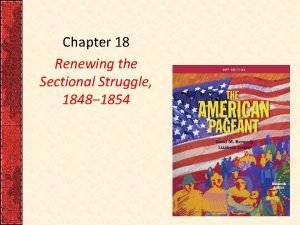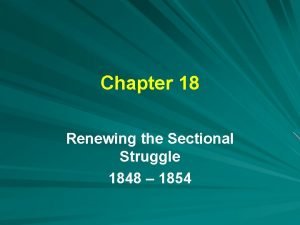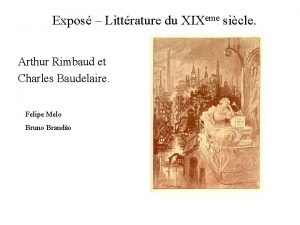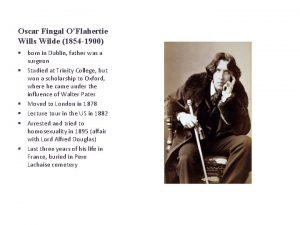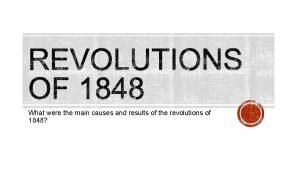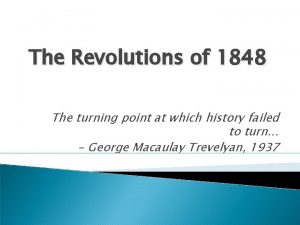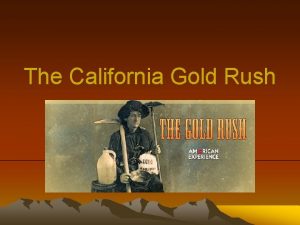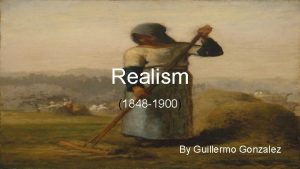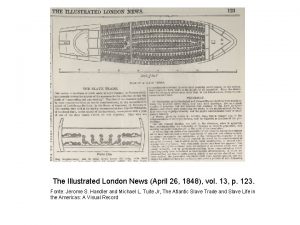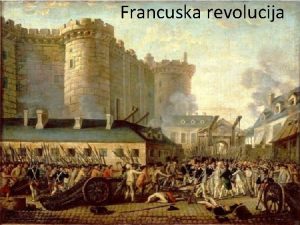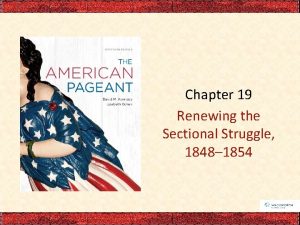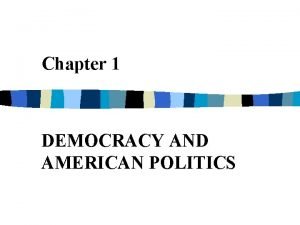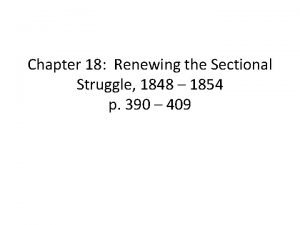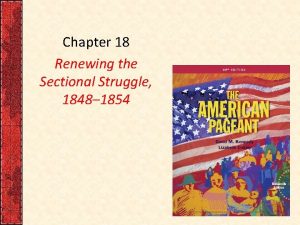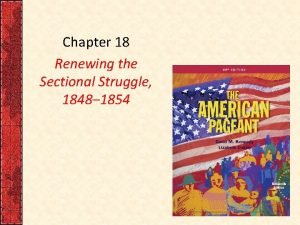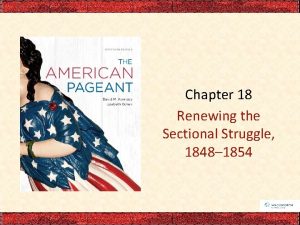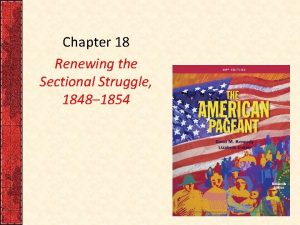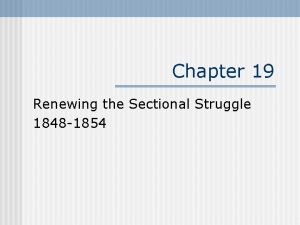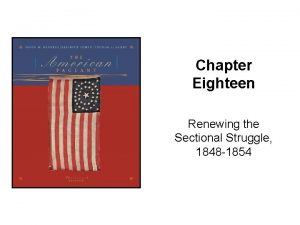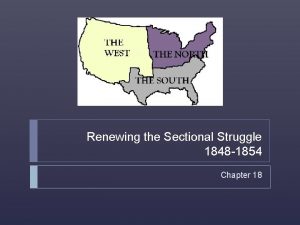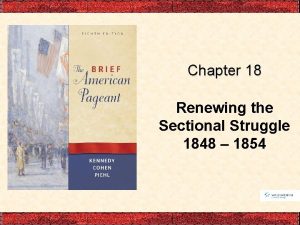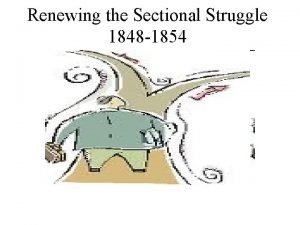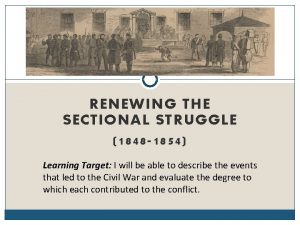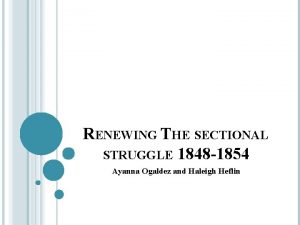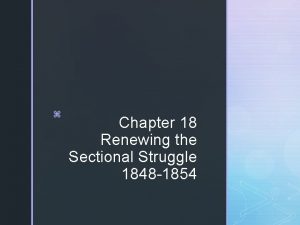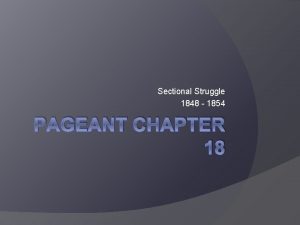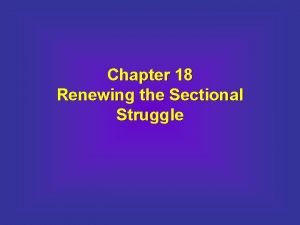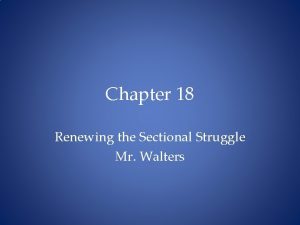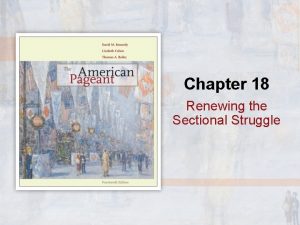Chapter 18 Renewing the Sectional Struggle 1848 1854









































































- Slides: 73

Chapter 18 Renewing the Sectional Struggle, 1848– 1854

I. The Popular Sovereignty Panacea • Democrats in 1848: – Polk pledged himself to a single term – National Convention turned to aging leader General Lewis Cass – Platform silent on burning issue of slavery – Cass's views were well known because he was reputed father of popular sovereignty

I. The Popular Sovereignty Panacea (cont. ) • Popular sovereignty— • doctrine stated the sovereign people of a territory, under general principle of the Constitution, should themselves determine status of slavery – Had persuasive appeal: • Public liked it because it accorded with democratic tradition of self-determination

I. Popular Sovereignty Panacea (cont. ) • Politicians liked it because it seemed a comfortable compromise between: – Free-soilers' bid to ban slavery in territories – Southern demands that Congress protect slavery in territories • Popular sovereignty tossed slavery problem to people in various territories • Advocates hoped to dissolve slavery from a national issue to a series of local issues • Yet, popular sovereignty had one fatal defect: – Might spread blight of slavery

II. Political Triumphs for General Taylor • Whigs – Nominated Zachary Taylor, “Hero of Buena Vista” – Platform: • Dodged all troublesome issues • Extolled virtues of their candidate • He would not commit himself on issue of slavery's extension

p 382

II. Political Triumphs for General Taylor (cont. ) • Free Soil party: – Organized by ardent antislavery Northerners • Came out for Wilmot Proviso and against slavery in territories • Broadened appeal by advocating: – Federal aid for internal improvement – Free government homesteads for settlers • Attracted industrialists opposed to Polk's reduction of protective tariffs

II. Political Triumphs for General Taylor (cont. ) • Appealed to Democrats resentful of Polk's settling for part of Oregon, while insisting on all of Texas • Harbored many northerners whose hatred was not directed at slavery as much as at African Americans: – Gagged at prospect of sharing new territories with blacks • Contained some “Conscience Whigs” who condemned slavery on moral grounds • Free soilers chose Van Buren

II. Political Triumphs for General Taylor (cont. ) • Free-Soilers' party platform: • Condemned slavery not so much for enslaving blacks but for destroying chances of free whites to rise up from wage-earning dependence to self-employment • Argued that only with free soil in West could American commitment to upward mobility continue to flourish • First party organized around issue of slavery and confined to single section • Foreshadowed emergence of Republicans

II. Political Triumphs for General Taylor (cont. ) • Taylor's wartime popularity: – 1, 360, 967 popular and 163 electoral votes • Cass: – 1, 222, 342 popular and 127 electoral votes • Van Buren – 291, 263 ballots and diverted Democratic strength from Cass in critical state of New York

III. “Californy Gold” • Discovery of gold near Sutter's Mill, California, early in 1848, (see Map 18. 1): – Most reliable profits made by those who mined the miners: • Charged outrageous rates for laundry & other services – “Forty-niners” chased dream of gold, most notably to Australia in 1851

Map 18 -1 p 383

p 384

III. “Californy Gold” (cont. ) • California gold rush: – Attracted tens of thousands of people – High proportion of newcomers were lawless men, accompanied or followed by virtueless women – Crime inevitably resulted – Robbery, claim jumping, & murder most commonplace

III. “Californy Gold” (cont. ) • Majority of Californians were decent, lawabiding citizens; needed protection: – Struggled to erect adequate state government • Encouraged by President Taylor, they drafted a constitution in 1849 that excluded slavery • Then appealed to Congress for admission, bypassing usual territorial stage • Would California be straw that broke back of the Union?

IV. Sectional Balance and the Underground Railroad • South in 1850 was relatively well-off: – National leadership: Taylor in White House – Had a majority in cabinet and on Supreme Court – Cotton fields expanding – Cotton prices profitably high – Few believed slavery seriously threatened in fifteen states • South deeply worried by ever-tipping political balance: 15 slave states & 15 free states

IV. Sectional Balance and the Underground Railroad (cont. ) • Admission of California would destroy delicate equilibrium in Senate • Potential slave territory under American flag running short • Already agitation in territories of New Mexico & Utah for admission as nonslave states • California might establish a precedent

IV. Sectional Balance and the Underground Railroad (cont. ) • Texas had additional grievances: – Huge area east of Rio Grande and north of fortysecond parallel – Embraced half of present-day New Mexico (see Map 18. 2) – Federal government proposed to detach area from Texas, but Texans threatened violence

IV. Sectional Balance and the Underground Railroad (cont. ) • Southerners: – Angered by agitation in North for abolition of slavery in District of Columbia – Alarmed by prospect of 10 -mile oasis of free soil between slaveholding Maryland & slaveholding Virginia – More disagreeable to South was loss of runaway slaves: • Assisted by Underground Railroad • Amazing conductor: Harriet Tubman

p 384

p 385

IV. Sectional Balance and the Underground Railroad (cont. ) • 1850: southerners demanded more stringent fugitive-slave law: – 1793 law inadequate to cope with runaways – Abolitionists who ran Underground Railroad did not profit from their lawlessness – Slave owners were losers – 1, 000 runaways a year out of some four million slaves – Masters argued Constitution protected slavery

Map 18 -2 p 385

V. Twilight of the Senatorial Giants • Congressional catastrophe in 1850: – Free-soil California wanted admission – “Fire-eaters” in South threatened secession • Planned to meet in Nashville, Tenn. to withdraw from Union – “Immortal trio”—Clay, Calhoun, & Webster— met in Congress for last time

V. Twilight of the Senatorial Giants (cont. ) • Henry Clay (73 years old) played critical role: – “Great Compromiser”—reprised role he played in Missouri and in nullification – Urged both North & South to make concessions – North partially yield by enacting more feasible fugitive-slave law

V. Twilight of the Senatorial Giants (cont. ) • Senator John C. Calhoun (88 years old and dying of tuberculosis): “Great Nullifier”: – Approved Clay's proposed concessions – Rejected them as not providing adequate safeguards for southern rights • Impassioned plea to leave slavery alone, return runaway slaves, give South its rights as minority, and restore political balance • Wanted to elect two presidents; one from North and one from South, each wielding a veto

V. Twilight of the Senatorial Giants (cont. ) • Daniel Webster (86 years old): – Upheld Clay's compromise measures – Urged all reasonable concessions to South, including new fugitive-slave law with teeth – As for slavery in new territories, he asked, why legislate when area not conducive to plantations – His conclusion: only solutions were compromise, concession, and reasonableness

V. Twilight of the Senatorial Giants (cont. ) • Webster's famed Seventh of March speech (1850) was his finest: – Visibly strengthened Union sentiment – Pleased banking and commercial centers of North—stood to lose millions by secession – Free-Soilers and abolitionists called him a traitor, worthy of bracketing with Benedict Arnold – Reproaches most unfair; Webster regarded slavery as evil, but disunion as worse

VI. Deadlock and Danger on Capitol Hill • Stormy congressional debate (1850) not over: – North's new Young Guard • William H. Seward: – Strong antislaveryite – Unequivocally against concession – Argued Christian legislators must obey God's moral law as well as man's mundane law

VI. Deadlock and Danger on Capitol Hill (cont. ) – Appealed to exclude slavery in territories with reference to even “higher law” than Constitution – Appeal may have cost him presidential nomination and presidency in 1860 – President Taylor bent on vetoing any compromise. – Ire aroused by threats of Texas to seize Santa Fe

VII. Breaking the Congressional Logjam • Taylor unknowingly helped cause of concession by dying suddenly. • Vice-President Millard Fillmore took reins: – As presiding officer of Senate, he was impressed with arguments for conciliation – Gladly signed series of compromise measures – Balancing of interests in Compromise of 1850 was extremely delicate (see Table 18. 1).

Table 18 -1 p 387

VII. Breaking the Congressional Logjam (cont. ) • Heat in Congress: – “Union savers”—Clay, Webster, Douglas— orated across North on behalf of compromise – Southern “fire-eaters” opposed concession – June 1850, southern extremists met in Nashville: • Took strong position in favor of slavery • Condemned compromise measure

VII. Breaking the Congressional Logjam (cont. ) – Second Era of Good Feelings dawned: • Talk of secession subsided – Peace-loving people, both North and South, determined that: • Compromises should be “finality” • Explosive issue of slavery should be buried

p 388

VIII. Balancing the Compromise Scales • Who got better deal from 1850 Compromise? • North (see Map 18. 3): – California (free state) tipped balance permanently against South – Territories of New Mexico & Utah open to slavery —basis of popular sovereignty – Nature—“highest law”—not favor slavery there

Map 18 -3 p 389

VIII. Balancing the Compromise Scales (cont. ) • South: – Urgently needed more slave territory to restore “sacred balance” – If not from recent conquests from Mexico, then Caribbean was one answer – Halted drive toward abolition in District of Columbia temporarily – Had to accept outlawing slave trade in D. C.

VIII. Balancing the Compromise Scales (cont. ) • Fugitive Slave Law (1850): – Stirred up storm of opposition in North – Fleeing slaves: • Could not testify on their own • Denied jury trial – Federal commissioner who handled case of a fugitive: • If runaway was freed, earned $5 • If not, earned $10

VIII. Balancing the Compromise Scales (cont. ) – Northerners who helped a slave escape were liable to heavy fines and jail time – “Man-Stealing” Law was abhorrent: • Touched off explosive chain reaction in North • Underground Railroad stepped up its timetable • Mass. made it a penal offense for any state official to enforce new federal statute • Other states passed “personal liberty laws” • Abolitionists protested vehemently against law

VIII. Balancing the Compromise Scales (cont. ) • Beyond question, Fugitive Slave Law a blunder by South • Slave catchers redoubled efforts • With delay of fighting during 1850 s: – North forged ahead in population and wealth—in crops, factories, foundries, ships, & railroads – Delay added immensely to moral strength of North – 1850 s did much to bolster Yankee will to resist secession, whatever the cost • Thus Compromise of 1850 won Civil War for Union (see Map 18. 4)

p 390

IX. Defeat and Doom for the Whigs • 1852 Democratic nominating convention in Baltimore: – Nominated “dark horse”—Franklin Pierce, from New Hampshire • Weak and indecisive figure • War injuries caused him to be known as “Fainting General” • Enemyless because he was inconspicuous • A prosouthern northerner, he was acceptable to slavery wing of Democratic Party

Map 18 -4 p 391

IX. Defeat and Doom for the Whigs (cont. ) • Platform revived commitment to territorial expansion as pursued by President Polk • Emphatically endorsed Compromise of 1850, incl. Fugitive Slave Law – Whigs convened in Baltimore: • Having won in past with war heroes, they turned to “Old Fuss and Feathers” Winfield Scott – Ablest American general of his generation

IX. Defeat and Doom for the Whigs (cont. ) – Whig platform praised Compromise of 1850 – Campaign degenerated into personal attacks – Whig party hopelessly split: • Antislavery Whigs in North accepted Scott as nominee but deplored his platform—which endorsed Fugitive Slave Law • Southern Whigs doubted Scott's loyalty to Compromise of 1850 and Fugitive Slave Law—accepted his platform but rejected candidate

IX. Defeat and Doom for the Whigs (cont. ) – General Scott, victorious on battlefield, met defeat at ballot box. – Free-soil John Hale took northern Whig votes from Scott – Hale took 5% of popular vote • Pierce won with 254 electoral vote to 42; – Popular count was closer: 1, 601, 117 to 1, 385, 453 • Election of 1852's frightening significance: – Marked effective end of Whig party

IX. Defeat and Doom for the Whigs (cont. ) • Whigs' complete death: – Augured eclipse of national parties and rise of purely sectional political alignments – Won two presidential elections (1840, 1848) with war heroes • Greatest contribution was to help uphold ideal of Union through: – Electoral strength in South – Eloquence of leaders Clay & Webster

X. Expansionist Stirrings South of the Border • Spirit of Manifest Destiny revived: • A continuous Atlantic-to-Pacific transportation route would effectively sever two Americas (see Map 18. 5) • British encroachment in area drove governments of United States & New Granada to conclude treaty in 1848 • Guaranteed American right of transit across isthmus in return for Washington's pledge to maintain “perfect neutrality” on route—“free transit of traffic might not be interrupted”

Map 18 -5 p 392

X. Expansionist Stirrings South of the Border (cont. ) • Agreement led to: • Theodore Roosevelt's assertion of American control of Panama Canal in 1903 • Led to construction of first “transcontinental” railroad – Clayton-Bulwer Treaty (1850) stipulated neither U. S. A. nor Britain would fortify or seek executive control over any future isthmian waterway • (later rescinded by Hay-Pauncefote Treaty of 1910; see Chap 27).

X. Expansionist Stirrings South of the Border (cont. ) • Southern “slavocrats” looked to Central America: – Adventurer, William Walker, tried repeatedly to grab control of Nicaragua • Installed himself president in July 1856 and promptly legalized slavery • Coalition of Central American nations formed alliance to overthrow him • President Pierce withdrew diplomatic recognition • Walker died before Honduran firing squad in 1860

X. Expansionist Stirrings South of the Border (cont. ) • Sugar-rich Cuba: • Enticing prospect for annexation • Already had large population of enslaved blacks • Might be carved into several states, restoring political balance in Senate • President Polk offered $100 million to Spain for Cuba, but Spain refused • Spanish officials in Cuba later seized American steamer Black Warrior • Opportunity for President to provoke war with Spain and seize Cuba

X. Expansionist Stirrings South of the Border (cont. ) • Secretary of state instructed American ministers in Spain, England, & France to prepare recommendations for acquisition of Cuba • The three, meeting in Ostend, Belgium, drew up topsecret dispatch: • Ostend Manifesto—urged administration to offer $120 million for Cuba • If rebuffed, then war justified • Secret manifesto leaked out • Northern free-soilers rose up in wrath against “manifesto of brigands”

X. Expansionist Stirrings South of the Border (cont. ) • Red-faced Pierce administration dropped reckless scheme for Cuba – Slavery issue checked territorial expansion in 1850 s

XI. The Allure of Asia • Could Americans tap more deeply the supposedly rich markets of Asia? – Opium War—fought by Britain for right to peddle opium in China: • Britain gained free access to five so-called treaty ports • Control of island of Hong Kong • President Tyler dispatched Caleb Cushing to secure comparable concession for United States • Cushing arrived at Macao in early 1844

XI. The Allure of Asia (cont. ) • Treaty of Wanghia: first formal diplomatic agreement between U. S. and China on July 3, 1844: – Cushing secured vital commercial rights and privileges from Chinese – “Most favorable rights” granted to U. S. A. – “Extraterritoriality”—provided Americans, accused of crimes in China, a trial before American officials, not in Chinese courts

XI. The Allure of Asia (cont. ) – American trade with China increased – Treaty also encouraged arrival of American missionaries; thousands came – Success in China prompted U. S. goals for Japan: • Japan had earlier withdrawn into cocoon of isolationism for over 200 years • Tokugawa Shogunate protected Japan's insularity • By 1853, Japan ready to emerge from self-imposed quarantine

XI. The Allure of Asia (cont. ) • President Fillmore dispatched Commodore Matthew Perry in 1852 for Japan • His four smoke-belching “black ships” steamed into Edo (later Tokyo Bay) on July 8, 1853 • Once on shore, Perry requested free trade & friendly relations, then left promising to return next year to receive Japan's reply • Perry returned in February 1854; persuaded Japan to sign Treaty of Kanagawa on March 31, 1854

p 394

XI. The Allure of Asia (cont. ) – Perry cracked open Japan's two-century shell of isolation – Less than a decade later, “Meiji Restoration” would: • End Shogunate • Propel Japan headlong into modern world • Eventually into military crash with United States

XII. Pacific Railroad Promoters and the Gadsden Purchase • Acute transportation problems another legacy of Mexican War – California & Oregon: 8, 000 miles west of nation's capital – Sea routes too long – Travel by wagon slow and dangerous – Feasible land transportation imperative – Transcontinental railroad only real solution

XII. Pacific Railroad Promoters and the Gadsden Purchase (cont. ) • Where to build railroad: north or south? • James Gadsden, minister to Mexico: – Santa Anna still in power and needed money – Gadsden negotiated Gadsden Purchase in 1853 – Ceded more territory to U. S. A. for $10 million – Best route for a southern railroad (see Map 18. 6) • In response, Northerners wanted Nebraska organized

Map 18 -6 p 395

XIII. Douglas's Kansas-Nebraska Scheme – Senator Stephen Douglas in 1854 sought to offset Gadsden's expansion to southwest • Longed to break North-South deadlock over westward expansion • Invested heavily in Chicago real estate & railway stock • Wanted Chicago to be eastern terminus for proposed railroad • Wanted to get South to support his scheme

XIII. Douglas's Kansas-Nebraska Scheme (cont. ) • Proposed territory of Nebraska be divided into two territories, Kansas and Nebraska (see Map 18. 7) • Slavery then decided by popular sovereignty • Kansas, west of slaveholding Missouri, presumably would choose to become a slave state • Nebraska, west of free-soil Iowa, presumably would become a free state • Douglas's scheme contradicted Missouri Compromise of 1820 (forbade slavery in Nebraska Territory north of 36 30' line)

Map 18 -7 p 396

XIII. Douglas's Kansas-Nebraska Scheme (cont. ) – Only way to open region to popular sovereignty was to repeal Missouri Compromise – To southerners here was chance for another slave state – President Pierce threw support to Kansas-Nebraska Bill – Douglas rammed bill through Congress, with strong support from many southerners – Douglas acted impulsively and recklessly – Predicted opposition in North, but grossly underestimated it

p 397

XIV. Congress Legislates a Civil War • Kansas-Nebraska Act: – One of most momentous measures to pass Congress – Greased slippery slope to Civil War: • • Infuriated antislavery northerners Future compromise would be much more difficult Fugitive Slave Law of 1850 became dead letter Act wrecked two compromises—of 1820 and of 1850

XIV. Congress Legislates a Civil War (cont. ) • Northern abolitionists and southern “fire-eaters” saw less and less they could live with • Ranks of antislaveryites gained numerous recruits • Democratic Party shattered by Kansas-Nebraska Act • Most durable offspring of Kansas-Nebraska blunder was new Republican Party

XIV. Congress Legislates a Civil War (cont. ) – Republican Party: • Sprang up in Middle West—Wisconsin & Michigan • Gathered dissatisfied elements, including Whigs, Democrats, Free-Soilers, Know-Nothings, and other foes of Kansas-Nebraska Act • Also included Abraham Lincoln • Grew rapidly, but a sectional party • Not accepted South of Mason-Dixon line – Union in dire peril

p 398
 Chapter 18 renewing the sectional struggle
Chapter 18 renewing the sectional struggle Chapter 18 renewing the sectional struggle
Chapter 18 renewing the sectional struggle Pure at heart definition
Pure at heart definition 1891-1854
1891-1854 1854
1854 Born in dublin 1854
Born in dublin 1854 Wood despatch 1854
Wood despatch 1854 Youthful offenders act 1854
Youthful offenders act 1854 Leto 1848 leto revolucij
Leto 1848 leto revolucij Leto 1848 in slovenci
Leto 1848 in slovenci Leto 1848 in slovenci
Leto 1848 in slovenci Willem i
Willem i Why did the italian revolution of 1848 fail
Why did the italian revolution of 1848 fail Bolzano (1781 – 1848)
Bolzano (1781 – 1848) Slidetodoc.com
Slidetodoc.com Austrian empire 1848
Austrian empire 1848 January 24 1848
January 24 1848 Revolucije u europi 1848
Revolucije u europi 1848 Realism (1848–1900)
Realism (1848–1900) Katonadalok 1848
Katonadalok 1848 Why did the 1848 revolutions fail
Why did the 1848 revolutions fail 1848 revolution germany
1848 revolution germany Anul 1848 in europa
Anul 1848 in europa Revolution 1848 verlauf
Revolution 1848 verlauf Julska monarhija
Julska monarhija Francúzska revolúcia 1848
Francúzska revolúcia 1848 Emancipace žen 1848
Emancipace žen 1848 Il 1848 in europa e in italia
Il 1848 in europa e in italia Großdeutsche lösung
Großdeutsche lösung Illustrated london news 1848
Illustrated london news 1848 Francuska revolucija 1848
Francuska revolucija 1848 Struggle chapter 19
Struggle chapter 19 Gerardo
Gerardo Principles of representative democracy
Principles of representative democracy Hình ảnh bộ gõ cơ thể búng tay
Hình ảnh bộ gõ cơ thể búng tay Ng-html
Ng-html Bổ thể
Bổ thể Tỉ lệ cơ thể trẻ em
Tỉ lệ cơ thể trẻ em Chó sói
Chó sói Thang điểm glasgow
Thang điểm glasgow Chúa sống lại
Chúa sống lại Môn thể thao bắt đầu bằng từ chạy
Môn thể thao bắt đầu bằng từ chạy Thế nào là hệ số cao nhất
Thế nào là hệ số cao nhất Các châu lục và đại dương trên thế giới
Các châu lục và đại dương trên thế giới Công thức tính độ biến thiên đông lượng
Công thức tính độ biến thiên đông lượng Trời xanh đây là của chúng ta thể thơ
Trời xanh đây là của chúng ta thể thơ Mật thư tọa độ 5x5
Mật thư tọa độ 5x5 Làm thế nào để 102-1=99
Làm thế nào để 102-1=99 Phản ứng thế ankan
Phản ứng thế ankan Các châu lục và đại dương trên thế giới
Các châu lục và đại dương trên thế giới Thể thơ truyền thống
Thể thơ truyền thống Quá trình desamine hóa có thể tạo ra
Quá trình desamine hóa có thể tạo ra Một số thể thơ truyền thống
Một số thể thơ truyền thống Cái miệng nó xinh thế
Cái miệng nó xinh thế Vẽ hình chiếu vuông góc của vật thể sau
Vẽ hình chiếu vuông góc của vật thể sau Biện pháp chống mỏi cơ
Biện pháp chống mỏi cơ đặc điểm cơ thể của người tối cổ
đặc điểm cơ thể của người tối cổ Ví dụ giọng cùng tên
Ví dụ giọng cùng tên Vẽ hình chiếu đứng bằng cạnh của vật thể
Vẽ hình chiếu đứng bằng cạnh của vật thể Vẽ hình chiếu vuông góc của vật thể sau
Vẽ hình chiếu vuông góc của vật thể sau Thẻ vin
Thẻ vin đại từ thay thế
đại từ thay thế điện thế nghỉ
điện thế nghỉ Tư thế ngồi viết
Tư thế ngồi viết Diễn thế sinh thái là
Diễn thế sinh thái là Dạng đột biến một nhiễm là
Dạng đột biến một nhiễm là Số nguyên tố là
Số nguyên tố là Tư thế ngồi viết
Tư thế ngồi viết Lời thề hippocrates
Lời thề hippocrates Thiếu nhi thế giới liên hoan
Thiếu nhi thế giới liên hoan ưu thế lai là gì
ưu thế lai là gì Khi nào hổ mẹ dạy hổ con săn mồi
Khi nào hổ mẹ dạy hổ con săn mồi Sự nuôi và dạy con của hổ
Sự nuôi và dạy con của hổ Sơ đồ cơ thể người
Sơ đồ cơ thể người
